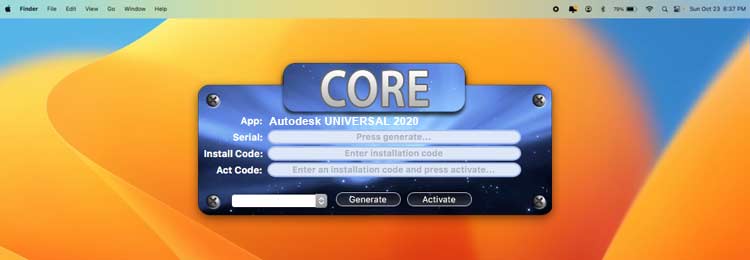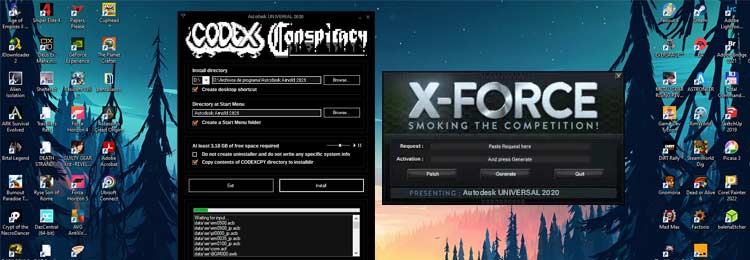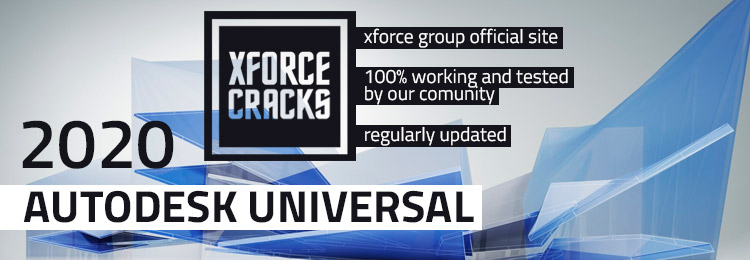Hello friends, great news! Here we bring you the latest version of the new Autodesk UNIVERSAL 2020 crack patch created by the people at CODEXCPY, CORE and our friends of XFORCE.
This version is a simplified version of PainteR group’s “universal patcher” but much easier to install.
It is very simple to install: just follow the steps of the installer and finally mount the .iso image and run setup.exe as shown in the video tutorial. It only has an advertisement, if you want to avoid advertising you can register in the forum and download and install it from there. Any questions can be asked in the forum directly to its authors. Thank you for your continued support!
Download our Autodesk UNIVERSAL 2020 crack-patch
Release Date: 8/27/2024 (Latest Windows version)
We kindly ask that you pass by a small ad to keep this website and forum up and running =)
Download CORE-KEYGEN Autodesk UNIVERSAL 2020 for mac
Release Date: 8/27/2024 (Latest macOS version)
We kindly ask that you pass by a small ad to keep this website and forum up and running =)
Autodesk UNIVERSAL 2020, Keygen & Crack
Keygen Version: v2.41.32
Release Date: 8/27/2024
Compatible with:
Microsoft® Windows® 11 or Windows 10 version 1809 or above
Apple® macOS® Monterey v12, Apple macOS Big Sur v11, Apple macOS Catalina v10.15
net framework 4.5 needed
Cracked by codexcpy.com & xforce-cacks.com


Autodesk has introduced a series of software bundles known as “suites.” These packages combine various Autodesk applications tailored to specific industries. The suites come in Standard, Premium, and Ultimate editions, with each level adding more software at a progressively higher (though still discounted compared to retail) price. For this review, I was provided with the Ultimate editions of the Design Suite and Product Design Suite for evaluation.
The Autodesk Design Suite includes applications such as Sketchbook Designer (formerly Alias Sketch), Alias Design, 3D Studio Max, Inventor Fusion, Showcase, and Mudbox. The Product Design Suite builds on this by including AutoCAD and Inventor Pro. While it would be overwhelming to cover each of these programs in detail, I’ll focus on how they integrate into an industrial design workflow.
To start, I tasked myself with designing a wireless desktop speaker. Rather than starting with Sketchbook Pro for initial concept sketches, I opted for Sketchbook Designer. This next-generation digital sketching tool by Autodesk builds on the interface of Sketchbook Pro while introducing new features. One of the standout features is full vector sketching—precise, editable, and incredibly fluid. If you’re familiar with the cycle of sketching, undoing, and re-sketching, you’ll appreciate the ability to lay down a clean line, adjust it, and continue without interruption. It takes some getting used to, but once you do, it’s a game-changer.
Sketchbook Designer allows for mixing vector and raster layers, offering great versatility. If you haven’t tried it yet, it’s definitely worth downloading a trial. Once I finished my sketch, I saved it in Sketchbook Designer’s native DWG format (you can also import/export as Sketchbook Pro TIF or Photoshop PSD).
Next, I opened the DWG file in Alias Design. Although the file imported successfully, it appeared empty at first. After some troubleshooting, I realized I needed to use the “Export Curves DWG” option in Sketchbook Designer. Back in Alias, the vector data imported perfectly as NURBS curves, providing a solid foundation for further modeling. The ability to snap curves to the sketch was particularly useful.
Key Features of Autodesk Suites:
- Boost efficiency: Intuitive tools simplify the measurement, markup, and review of 2D and 3D designs directly on your desktop.
- Enhance communication: Share updates with your team and stakeholders, even if they lack the original design software.
- Cut costs: Reduce paper usage and minimize misunderstandings.
- Optimized performance: Enjoy improved tools and features, especially if you’re transitioning from DWF Viewer or Volo View.
- Advanced viewing: Open and view high-resolution drawings, maps, and models with ease.
- Precise measurement: Measure parts, areas, surfaces, and dimensions accurately.
- Comprehensive markup and annotation: Add detailed comments, information, and suggestions to 2D and 3D files.
- Change tracking and importing: Efficiently manage, track, and reimport changes into the original design software to complete the review process.
- Reliable printing: Experience the same print quality as in the original design software.
Alias Design continues to evolve, adding new features and enhancements. It remains unmatched in providing ultimate control over NURBS surface creation. While parametric surface modeling is becoming more prominent, I would love to see Alias Design further refine blend curves and construction history.
After completing the A-side exterior surfaces of my speaker design, I moved on to solid modeling. Inventor Pro, Autodesk’s parametric design and engineering tool, is a powerful option within the Product Design Suite.
However, Inventor Fusion, a newer solid modeler included with Alias Design, caught my attention. By selecting my surfaces and sending them to Inventor Fusion, I was able to transition seamlessly into solid modeling. Inventor Fusion’s clean, streamlined interface (a simplified version of Inventor’s UI) made the process smooth, and the selected Alias surfaces imported effortlessly.
New xforce keygen modeling tool
Fusion may have a similar interface to Inventor, but it lacks parametric capabilities. It functions as a direct modeling tool that supports both solid and surface modeling, without a specific build sequence. While you can delete or merge features and components into the main model, you can’t easily edit or reverse them. One exception is the fillet tool, which does allow for adjustments to the fillet radius even after its creation.
I then mirrored, patched, and knitted surfaces together to form a symmetrical solid body. After that, I created a sketch to define a parting line, extruded it as a surface, and split the solid accordingly. Both Inventor Fusion and Inventor feature a context-sensitive interface. Small buttons appear relative to the tool or selection and float near the mouse cursor. For example, clicking on a sketch will make a small extrude button appear, and hovering over it reveals additional options. I found these floating buttons to be quite useful.
My assumption about Fusion is that it’s designed for Alias Design users who want to convert A-surfaces into solid bodies and add basic features before passing them to engineers. However, I noticed that while Inventor supports Alias WIRE format, the compatibility with Fusion’s DWG files is not as seamless. To transfer solid bodies from Fusion to Inventor, I had to export them in the STEP format.
Autodesk Civil 3D: Advanced Software for Civil Infrastructure Design
Autodesk Civil 3D is powerful design software aimed at civil engineers, providing the tools needed to tackle complex infrastructure projects in a 3D model-based environment.
- Speed up design and documentation
- Enhance design automation
- Facilitate collaboration and coordination
Benefits of Using Civil 3D
- Optimize Design Workflows
Civil 3D improves productivity and quality with its dynamic 3D model-based design and documentation environment. - Simplify Collaboration
Real-time updates and seamless sharing with other Autodesk software enhance teamwork during design, analysis, and construction phases. - Better Data Exchange
The software offers interoperability with other programs through common formats like IFC, addressing complex design requirements.
Fusion, as a relatively new software, showed some instability during my tests, often crashing. However, when it functioned, it offered an enjoyable user experience.
I had previously heard that Inventor Pro supports Alias WIRE as a referenced component, meaning that surfaces from a WIRE file can be integrated into an Inventor assembly. If the designer updates the WIRE surfaces in Alias, the Inventor assembly will automatically refresh to reflect those changes, keeping the feature tree up to date. This capability to directly move geometry from Alias to Inventor Pro was another functionality I wanted to explore.
After placing my WIRE file with referencing enabled, I initially struggled with how to refresh the WIRE file in Inventor after changes. I finally realized that using the rebuild tool was necessary with this better xforce keygen for this autodesk 2020 suite. If some WIRE surfaces were missing, Inventor provided a “replace this with that” option. Once I understood this, the process became straightforward: splitting, shelling, filleting, extruding cuts for grills, embossing logos—all these steps were easily managed.
Showcase is intuitive and fast
As the final step in my workflow, I used Alias Showcase, Autodesk’s specialized renderer. Showcase is intuitive and fast, yet offers enough depth and options to produce high-quality presentation images. Its real-time live rendering engine is robust enough for both presentations and evaluations. Even with the settings maximized, the performance remained smooth on a MacBook Pro, and even better on more powerful desktop setups. Showcase supports various file formats, and I had no issues importing geometry from Alias, Fusion, or Inventor. In under 15 minutes, I was able to assign shaders, choose an environment, and position my camera.
As a consultant, my software choices are heavily influenced by client preferences, especially when engineering gets involved. Expanding robust support for SolidWorks across the Autodesk suite would significantly enhance its appeal.
While the integration among Autodesk tools may not be as tight as I’d prefer, the suite still offers powerful and comprehensive solutions, covering more than 90% of my industrial design workflow. These software suites are a compelling choice at a price point comparable to that of a single flagship product like Alias Design, AutoCAD, or Inventor Pro. Despite the growing ubiquity of the DWG format, it’s worth noting that multiple versions exist, leading to compatibility challenges, as I’ve seen with Sketchbook Designer, Alias, and Fusion.
Autodesk is clearly aiming to make its software suite the go-to for product development professionals throughout the entire design process. The encouraging news is that these tools are moving towards better integration, fostering the growth and presence of an Autodesk-centric design and development ecosystem on various workstations.
Note: Use these tools with a structured approach to optimize productivity and achieve a seamless workflow across different stages of product development.
We believe that cracking and sharing softwares is something great and needed, but please never forget to support his creators. If you can afford the product PLEASE buy it =)
*—————–* !!!!! Accept no imitation / X-FORCE * * We are the world #1 !!!!! *——————*
**********************************************************************************************************


Hey, I\’ve made a mistake and I closed down keygen before activation. I did not work after reopening it or even after uninstalling and installing again. Do I get only one shot at this or is there still something I can do? Cheers
Thank you!!!!
Thanks Guys!
thanks
Many thanks
Download link?
does anybody have the key
Merci par avance.
great program thank you
Thanks for this share
Hi, How about Keygen for Corel WordPerfect Office 2020? This version is released some time ago.
2020 is no longer available to d/l its 2021 now. Please advise as to workaround? TIA
Hi NuclearStorm, Could you upload some instructions? Thanks
works for me
thank you very much.
Works great! Thanks!
Just a newbie, a keygen will always set it off.
Thank you and cheers!
TNX MAN!!!